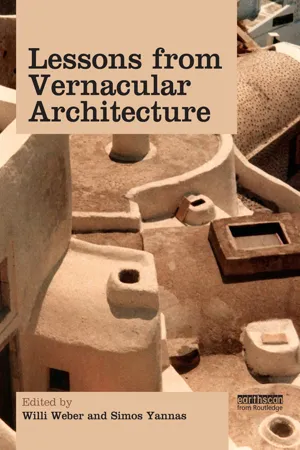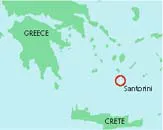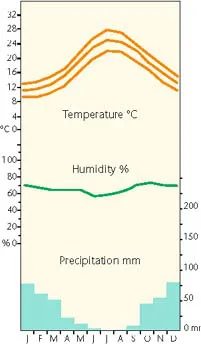
- 240 pages
- English
- ePUB (mobile friendly)
- Available on iOS & Android
eBook - ePub
Lessons from Vernacular Architecture
About this book
The architectural community has had a strong and continuing interest in traditional and vernacular architecture. Lessons from Vernacular Architecture takes lessons directly from traditional and vernacular architecture and offers them to the reader as guidance and inspiration for new buildings. The appropriate technical and social solutions provided by vernacular and traditional architecture are analysed in detail. International case studies focus on environmental design aspects of traditional architecture in a broad range of climatic conditions and building types.
Frequently asked questions
Yes, you can cancel anytime from the Subscription tab in your account settings on the Perlego website. Your subscription will stay active until the end of your current billing period. Learn how to cancel your subscription.
No, books cannot be downloaded as external files, such as PDFs, for use outside of Perlego. However, you can download books within the Perlego app for offline reading on mobile or tablet. Learn more here.
Perlego offers two plans: Essential and Complete
- Essential is ideal for learners and professionals who enjoy exploring a wide range of subjects. Access the Essential Library with 800,000+ trusted titles and best-sellers across business, personal growth, and the humanities. Includes unlimited reading time and Standard Read Aloud voice.
- Complete: Perfect for advanced learners and researchers needing full, unrestricted access. Unlock 1.4M+ books across hundreds of subjects, including academic and specialized titles. The Complete Plan also includes advanced features like Premium Read Aloud and Research Assistant.
We are an online textbook subscription service, where you can get access to an entire online library for less than the price of a single book per month. With over 1 million books across 1000+ topics, we’ve got you covered! Learn more here.
Look out for the read-aloud symbol on your next book to see if you can listen to it. The read-aloud tool reads text aloud for you, highlighting the text as it is being read. You can pause it, speed it up and slow it down. Learn more here.
Yes! You can use the Perlego app on both iOS or Android devices to read anytime, anywhere — even offline. Perfect for commutes or when you’re on the go.
Please note we cannot support devices running on iOS 13 and Android 7 or earlier. Learn more about using the app.
Please note we cannot support devices running on iOS 13 and Android 7 or earlier. Learn more about using the app.
Yes, you can access Lessons from Vernacular Architecture by Willi Weber, Simos Yannas, Willi Weber,Simos Yannas in PDF and/or ePUB format, as well as other popular books in Architecture & Architecture General. We have over one million books available in our catalogue for you to explore.
Information
PART I
Bioclimatic Facets of Vernacular Architecture
1
THE FOUR ELEMENTS OF SANTORINI'S ARCHITECTURE
Introduction
The four elements concept
According to a long line of scholars, from the ancient Greek philosophers to the medieval alchemists, the very essence of nature is a combination of four key elements in various configurations and interactions:
 | fire (e.g. sunlight, volcanoes); |
 | earth (e.g. soil and most materials); |
 | air (e.g. wind, oxygen); |
 | water (e.g. sea, rain). |
An obscure fifth element (‘ether’?) of a rather spiritual nature is thought to bind the other four together, being the catalyst of life.
Greek philosophers linked these elements to the five Platonic solids, and Aristotle related the four main elements to our senses, with additional reference to the four seasons (Figure 1.1).
The philosophical aspects of the four elements are not the issue here; instead, it is their utilization as a systematic tool to look at architecture in relation to nature.
The vernacular settlements of Santorini are an excellent case to demonstrate that approach, as they offer numerous features at various scales that manifest the connection between the built environment and the four elements, exemplifying the influence of the natural forces

MAP 1 Santorini, Greece

GRAPH 1 Santorini, Greece

FIGURE 1.1 The Platonic solids
in shaping architecture. From minute building details to entire neighbourhoods, from man-made structures to natural formations, Santorini seen through the ‘four elements prism’ highlights not only the power of nature but also the traditional response to natural conditions — and perhaps the effects of the contemporary lack of it.
The island of Santorini
Santorini or Thira is a striking natural example of the interaction between the four elements: it is a group of islands around the bay of Caldera, 90km north of Crete, remnants of a gigantic volcanic eruption (ca. 1500 BC) that obliterated the Minoan society of Crete with colossal tidal waves and a cataclysm of ash, perhaps also causing the natural phenomena described in Biblical Exodus (Figure 1.2).

FIGURE 1.2 The volcanic Caldera of Santorini; the dark islet in the middle was formed by eruptions as recent as 1950
Several scholars believe that Santorini was the legendary Atlantis that vanished due to a sudden natural disaster as described by Plato. Recent excavations have revealed a large settlement about thirty-five centuries old, well preserved under thick volcanic ash layers, which many believe is a trace of the famous lost civilization (Figure 1.3).
The landscape still bears clear marks of the great eruption: towards the crater there are steep red and black rock cliffs up to 300m high covered with light-coloured ash and pumice, and on the outer side there are smooth hills and long beaches with dark sand. The volcano remains active, as indicated by the sulphur-coloured warm water surfacing at the middle of Caldera bay, which is almost 400m deep.
Santorini climate
Climatic conditions are typical of the south Aegean region, with long sunshine and low precipitation. Humidity is fairly high even in summer due to the seawater mass, and for the same reason seasonal temperature fluctuations are rather limited generating mild winters and summers Winds usually come from the north quite strongly — especially in winter — although the ones from the south can be fairly severe too. Despite the widespread perception of the Greek islands as warm places, the Santorini climate is rather cool during several months, and comfortable conditions can be improved by the intense solar radiation — but also worsened by the forceful winds (Figures 1.4 to 1.8).

FIGURE 1.3 Detail from an Akrotiri fresco from the seventeenth century BC

FIGURE 1.4 Mean ambient temperature and humidity in Santorini lie within the comfort zone for most of the year, but with a substantial period on the cold side

FIGURE 1.5 Santorini is as rich in sunshine as poor in water

FIGURE 1.6 Mean ambient temperature exceeds 20°C during four months only; daytime temperatures can go much higher due to solar radiation

FIGURE 1.7 The sea mass sustains high relative humidity all year round; rainfall is rare during summer

FIGURE 1.8 Santorini is a windy place all year long
Santorini architecture
The built fabric
The old settlements of Santorini — as in most small Aegean islands — are placed far from the shore: the fear of pirate assaults forced the locals to settle on steep cliffs or hidden valleys that offered better defence or were harder to spot from the sea (Figure 1.9). High density, narrow streets and small buildings have resulted from many factors: shortage of safe land, mutual protection from the wind and solar heat, security, family growth, saving of construction materials and the highly communal spirit of the old societies (Figure 1.10). In similar cases, for example, Mykonos and Astypalea, densities of up to one person per square metre have been reported, so we can imagine crammed conditions in Santorini too — without counting the numerous domestic animals, from chicken to donkeys.
Oia, a villa...
Table of contents
- Cover Page
- Half Title page
- Title Page
- Copyright Page
- Contents
- List of illustrations
- List of contributors
- Introduction
- Part I Bioclimatic Facets of Vernacular Architecture
- Part II Vernacular Architecture as Model
- Index